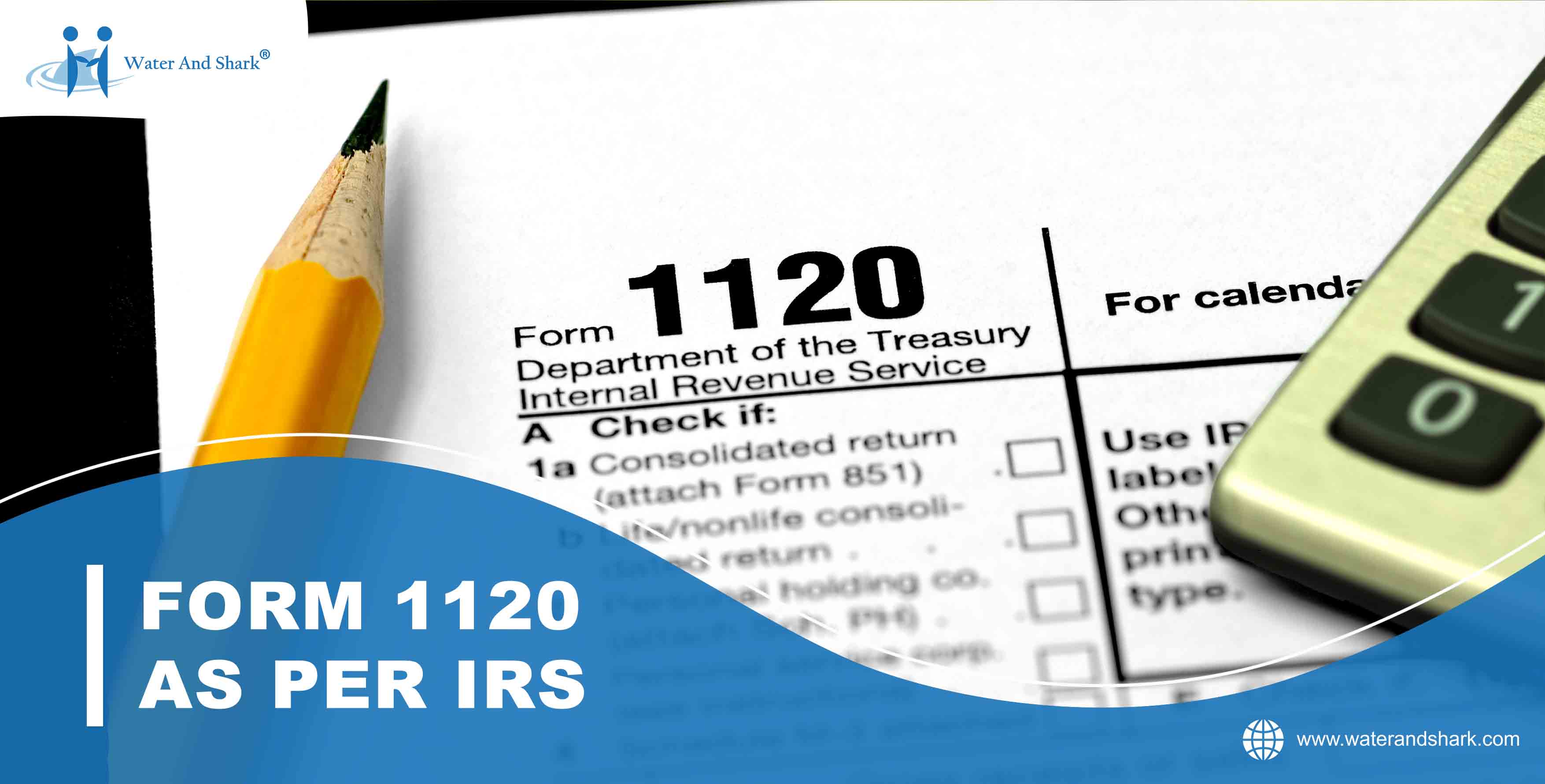Form 1120: Understanding U S Corporation Income Tax Return
March 31, 2024 waterandshark
Form 1120 captures the financial and taxation intricacies of corporations. The importance of accurate financial record-keeping and thorough apprehension of tax regulations. This form in particular is a key instrument in taxation landscape for more transparency in taxation of corporate entities in the USA and fulfilling their obligations with the USA. In the blog we will learn more about the form, its different variations, due dates and rates etc of the corporations.
Jump right in:
What is Form 1120?
Form 1120 and its types
What is the structure of Form 1120?
How are Corporations taxed?
Estimated Taxes for Corporations
What are the tax rates for Corporations?
What are the schedules in the Form 1120?
When is the due date of filing the form 1120?
Where to file Form 1120?
What are the various documents or details required while filing this form?
Conclusion
What is Form 1120?
Form 1120: U.S. Corporation Income Tax Return form is a federal tax return. All domestic corporations must file the tax returns to determine their annual income tax liability. It is used to report income, gains, losses, deductions, and credits, that impact the overall tax liability of a corporation. Several schedules and attachments accompany Form 1120, adding an extra layer of detail to their tax reporting. Let us discover in detail!
Form 1120 and its types:
Form 1120 has various types for different taxpayers within corporate-like structures. The variations are due to their characteristics, activities, and elections made for reporting to authorities. The breakdown of different types of the form are as follows:
|
Form |
Tax-payer type |
|
Form 1120 |
C Corporations |
|
Form 1120S |
S Corporations |
|
Form 1120 C |
Co-operative Associations viz. farmers’ cooperatives |
|
Form 1120 H |
Homeowners’ Associations |
|
Form 1120 L |
Life Insurance Companies |
|
Form 1120 F |
Foreign corporations with income that is “effectively connected” with a USA trade or business |
What is the structure of Form 1120?
Form 1120 which specifically deals with tax returns of C Corporations or LLCs electing to be a C-Corporation is divided into the following sections:
- Personal details: Personal details like name, address, EIN, Date of incorporations.
- Income: Information like gross receipts/sales, returns and allowances, cost of goods sold, dividends, interests, rents, royalties, capital gains or losses, and other games.
- Deductions: Information on expenses like salaries and wages, repairs and maintenance, bad debts, rent paid, interest paid, depreciation, advertising and such other deductions.
- Tax: Tax liability or refund on Taxable Income is reported after taking into consideration tax credits and interests.
How are Corporations taxed?
Generally, C-corporation pays tax on its income, after offsetting income with losses, deductions, and credits. A corporation pays its shareholders dividends from its after-tax income. The shareholders then pay personal income taxes on the dividends. This is the often-mentioned “double taxation”.
S-corporations are unlike C-corporations in a way that the former are “pass through entities”. Because of pass-through taxation, the S-Corporation doesn’t pay federal income tax on its business income the way a C-Corporation does.
Estimated Taxes for Corporations
Corporations who estimate that their tax (incomes tax less credits) to be $500 or more must generally make estimated tax payments using form 1120-W. The payments are made quarterly after reviewing the estimated income during each quarter. The final corporate tax liability is determined after completing form 1120.
What are the tax rates for Corporations?
The corporate tax rate is a tax levied on a corporation's profits, collected by a government as a source of income. It applies to a company's income, which is revenue minus allowable expenses, deductions and tax credits. At present the federal corporate tax rate is a flat 21%.
What are the schedules in the Form 1120?
There are many additional attachments to the form 1120 which give more comprehensive understanding of the financial information of corporations to the IRS. Depending on the type of income you need to report, it may be necessary to attach additional schedules to the form 1040.
|
Form 1120 schedules |
Information |
|
Schedule -C |
Dividends, Inclusions, and Special Deductions This schedule reports dividends received from both foreign and domestic subsidiaries, including income from debt-financed and public utility stock, as well as earnings from affiliates and other entities. |
|
Schedule-J |
Tax computation This section helps to account for the tax liabilities by taking in the information on your business tax credits and estimated tax payments. |
|
Schedule-K |
Other information This section requires the taxpayer to input additional details about the owners, business activity, holdings in other companies and such other information. |
|
Schedule- L |
Balance sheet as per books This section requires the information on corporation’s assets and liabilities as per the books maintained by them. |
|
Schedule M-1 & Schedule M-2
|
Due to difference in IRS calculations of expenses with the ones calculated according to the GAAP, M-1 & M-2 schedules reconciles and analysis of retained earnings. |
|
Other Schedules |
Some other common attachments include: Form 1125-A,1125-E, 4797, 4563 and Schedule D |
When is the due date of filing the form 1120?
This form is due on the 15th day of the 4th month after the end of the corporation's tax year. However, a corporation with a fiscal tax year ending June 30 must file by the 15th day of the 3rd month after the end of its tax year. If the due date falls on a Saturday, Sunday, or legal holiday, the corporation can file on the next business day.
Where to file Form 1120?
In general, corporations can electronically file (e-file) Form 1120 and all related forms, schedules, and attachments. If the electronic filing is rejected, the return may be submitted via mail. The location of the company, the address on the tax return, and/or the type of return determine the location of the IRS processing centre for submissions.
What are the various documents or details required while filing this form?
Some major documents or details required during the filing of this form are as follows:
- EIN- Employer Identification Number
- Gross receipts or invoices
- Total assets and income
- Date of incorporation
- Business name
- Explanation of changes if any
- Business address
- Forms 1099, Schedules K-1, Records of all expenses
- Record of all the incomes, expenses, allowances and deductions if not covered by an forms
- Payments and credits
- Tax due or overpayment.
- Signature
Conclusion:
To conclude, while filing Form 1120 with IRS, diligence and attention to detail are a few of the most required attributes. No matter what your scale of business is, staying informed about the latest updates to tax laws and regulations is paramount for ensuring compliances and increasing the overall financial well-being of the company. Filing returns is also an opportunity to assess the business’s finances and carve out various tax saving strategies.
It is imperative to take professional guidance to accurately complete 1120 to avoid common filing errors. Reach out to our professional experts at Water and Shark for accurate and smooth tax filing process.





Comment